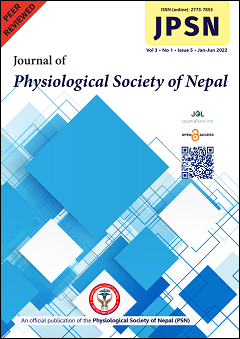Determination of different adiposity indices among students of a medical college of Nepal: A cross-sectional study
DOI:
https://doi.org/10.3126/jpsn.v3i1.57765Abstract
Background : The prevalence of overweight and obesity is on an increasing trend these days. Adverse effect of obesity can be seen in different physiological functions. This study aimed to see the fat distribution among students using different markers of obesity.
Methods : A cross sectional observational study was carried out in the Department of Physiology, National Medical College, which included 250 students. Body fat percentage was measured using Omron body composition monitor and waist circumference was measured using non-stretchable tape. Body Mass Index, Body Adiposity Index, Fat Mass and Waist Hip Ratio were calculated.
Results : Among 127 male subjects 8.7% were overweight and 18.1%, 47.2%, and 33.1% had high and 7.9%, 15%, 10.2% had very high fat percentage which was obtained from Body Fat Percentage, Body Adiposity Index, and Fat Mass respectively. Similarly, 4.7% and 48.8% had high Waist Circumference and Waist Hip Ratio respectively. Among 123 female subjects 9.8% were overweight and 1.6% were obese. 21.1%, 5.7% and 28.5% had high and 4.1%, and 0.8% had very high fat percentage which was obtained from Body Fat Percentage, and Body Adiposity Index respectively. Also 5.7% and 38.2% had high Waist Circumference and Waist hip Ratio respectively.
Conclusion : The study showed high prevalence of overweight and obesity when measured by other adiposity indices than by body mass index.
Downloads
Downloads
Published
How to Cite
Issue
Section
License
Copyright (c) 2023 Journal of Physiological Society of Nepal

This work is licensed under a Creative Commons Attribution-NonCommercial 4.0 International License.

